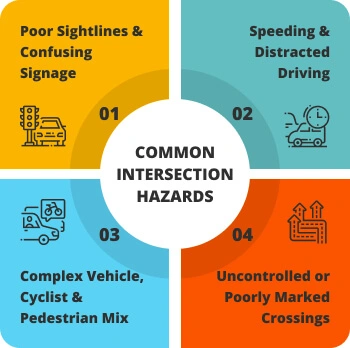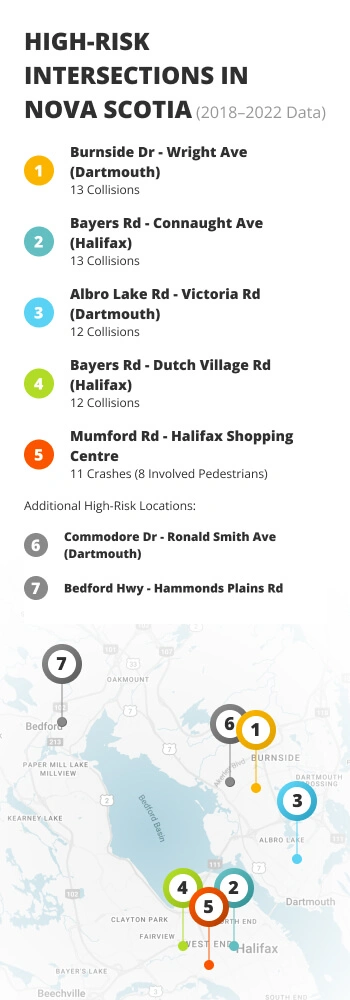Most Dangerous Intersections in Nova Scotia, Canada
In 2024, Nova Scotia recorded 77 fatal vehicle collisions, a 71% surge from the previous year’s total of 45. For a province of under a million people, this dramatic spike signals a worsening crisis, significantly increasing cases for personal injury lawyers. The roads, especially at critical intersections, are becoming deadlier. Despite years of planning, public safety campaigns, and urban redesigns, too many lives are still being lost or changed forever in places where roads meet.
Understanding why this is happening, and where, is essential. These are not isolated tragedies but part of a broader pattern that affects drivers, pedestrians, and cyclists alike.
Call 1-833-405-8282 to speak with our Eastern Canada legal team
Call 1-833-405-8282 to speak with our Eastern Canada legal team
A National Problem with Local Consequences
Canada has long struggled with road safety, but Nova Scotia has consistently stood out for the wrong reasons. According to a 2017 national study, Halifax had the worst collision frequency in the country, with 7.9 crashes per 100 vehicles. Provincially, Nova Scotia held the highest overall rate at 6.1%.
These numbers are not new, and they are not the result of a single year’s anomalies. They suggest an ongoing problem. Nova Scotia’s transportation infrastructure and driver culture may not have adapted fast enough to the realities of increased traffic, growing urban density, and shifting commuting patterns.
Urban and Rural Roads: Different Realities, Same Toll
Halifax is often the main focus in road safety discussions, but dangers stretch across the province. In 2020, Nova Scotia recorded over 5,000 injuries and 62 road fatalities. Halifax alone averaged 5,435 motor vehicle collisions each year. A reminder that while the capital city carries much of the traffic load, it is part of a wider provincial problem.
Urban centres like Halifax face dense traffic, rapid-fire stoplights, and pedestrian-heavy zones. In rural Nova Scotia, the story is different but no less concerning: high-speed roads with poor lighting and fewer safety measures still account for a considerable share of fatal crashes. Drivers in these areas might feel more confident on less busy roads, which can lead to increased risk-taking, especially around uncontrolled or poorly marked intersections.
Why Intersections Are High-Risk Zones

When crashes happen, nearly half occur at intersections. In Halifax, a major number of collisions in 2021, 2,163 out of 4,906, took place at these points. Intersections are the crossroads of the transport system, and they are often where complexity leads to reduced caution.
Poor design can be part of the problem. Sharp angles, poor sightlines, confusing signage, and irregular signal patterns make certain intersections more hazardous than others. But behaviour also plays a role. Speeding, distracted driving, and failure to yield right-of-way are common at busy crossings, especially during peak hours. Intersections concentrate different types of users: vehicles, bikes, pedestrians, and mistakes become much more costly. In 2021, Halifax recorded 150 pedestrian collisions and 61 involving cyclists. Most occurred in or near intersections, where road design and driver awareness often fall short in protecting more vulnerable users.
There was a dip in intersection crashes during the COVID-19 pandemic, with intersection crashes in Halifax dropping from 2,613 in 2019 to 2,006 in 2020. This would make sense given the reduced traffic during the pandemic, but by 2021, figures began rising again, reaching 2,163.
How Nova Scotia Compares Nationally and Why it Matters
Nova Scotia’s status as a high-risk province for road users has remained consistent. The 2017 national data highlighting Halifax’s ranking was not a one-off. The province’s road safety record has often been worse than the national average and, in some cases, the worst in the country.
There have been signs of improvement. Fatalities in Halifax fell from 15 in 2021 to 11 in 2022 and 6 in 2023. But this modest drop was not sustained. Province-wide, the sharp rise in 2024 fatalities suggests these gains may have been temporary or uneven. When progress does occur, it often follows short-term safety campaigns or isolated redesign efforts. The problem is far larger and more complex than one year’s numbers.
Where the Danger Is Most Acute

The capital continues to be the epicentre of many of Nova Scotia’s most dangerous intersections. Halifax reported 5,527 collisions in 2023, up from 5,257 in 2022. While deaths declined from 11 to 6, injuries climbed slightly from 776 to 785.
Some intersections in Halifax and neighbouring Dartmouth have recorded high levels of injury or fatal incidents over the past five years. The following locations have emerged as particular trouble spots, based on 2018–2022 data:
- Burnside Drive and Wright Avenue in Dartmouth experienced 13 injuries or fatal collisions during that period. The area sees heavy industrial traffic and frequent turning movements, contributing to the danger.
- Bayers Road at Connaught Avenue in Halifax also saw 13 injury or fatal incidents. This intersection is a key access point to nearby residential areas and suffers from congestion and complex lane changes.
- Albro Lake Road and Victoria Road in Dartmouth reported 12 injury or fatal crashes. As a commuter-heavy corridor with weak visibility, this crossing has faced ongoing challenges with traffic flow and safety.
- Bayers Road at Dutch Village Road and Joseph Howe Drive, a major convergence point, also saw 12 serious incidents. The configuration here is notably complex, with several merging and diverging routes.
- Mumford Road at Halifax Shopping Centre recorded 11 injury collisions, 8 involving pedestrians. The retail-heavy area has high foot traffic and limited crossing infrastructure.
- Other high-risk sites include Commodore Drive and Ronald Smith Avenue in Dartmouth, and Bedford Highway at Hammonds Plains Road. These intersections deal with a mix of local and through traffic and often lack the traffic-calming features seen in newer road developments.
These locations reflect a mix of issues, from infrastructure that hasn’t kept up with traffic growth to designs that don’t prioritize pedestrian safety.
What’s Being Done and What’s Still Missing
City and provincial authorities have responded with a range of measures over the past decade. These include intersection redesigns, pedestrian countdown timers, increased signage, and awareness campaigns aimed at reducing speeding and distracted driving.
The drop in fatalities from 2021 to 2022 in Halifax, though short-lived, suggests some interventions may be having a positive effect. But overall traffic collisions and injuries have not seen the same progress. In some cases, road redesigns are implemented only after public outcry or after severe incidents.
There have been calls for more investment in roundabouts, which tend to reduce serious crashes by eliminating the high-speed angle collisions common at traditional intersections. Expanded bike lanes, improved pedestrian crossings, and better lighting have also been stated as critical needs.
However, Nova Scotia still lacks a unified provincial road safety strategy that places intersection reform at its core. Without long-term investment and systematic updates to older road networks, the same issues are likely to persist. This is particularly the case in high-traffic zones that mix heavy vehicle flow with foot traffic.
Looking Ahead
The road safety conversation in Nova Scotia is not new, but it is shifting. As fatalities rise and injuries continue to mount, data is becoming harder to ignore. Intersections are a clear and present danger, not because of chance, but because of factors that can be addressed with focused action.
The record 77 road deaths in 2024 should not be seen as an outlier. It is part of a trajectory. Unless intersection reform becomes a consistent priority, short-term gains will be offset by long-term risks.
Public awareness is growing. So is frustration. Residents and councillors are increasingly vocal about unsafe crosswalks, confusing signage, and the absence of cyclist protections. And while city planners face budget and logistical constraints, the need for change is a constant topic.
Intersection redesign, consistent data monitoring, and smarter urban planning are necessities for reversing Nova Scotia’s road safety crisis. Whether these steps will be taken before more lives are lost remains to be seen. Until then, every crossing, every left turn, and every commute carries a risk that, for many Nova Scotians, has become all too familiar.
If you or a loved one has been injured at a dangerous intersection in Nova Scotia, contact Preszler Injury Lawyers to learn your legal options.
The statistics and facts in this article are based on available data as of the publication date. While efforts have been made to ensure accuracy, details can change over time. This content is, therefore, for informational purposes only and should not be used as professional advice.
Connect With Our Legal Team
Schedule a call with our personal injury legal intake team. Our team is available 24/7 so call us now to book your call. Our scheduled intake allows you to tell us details about your accident and gives our legal team an opportunity to review your case and advise you on possible solutions and outcomes. The best part is, if you decide to hire us after this call – you don’t pay anything unless we win. We can help clients regardless of where they reside in Nova Scotia & New Brunswick so let us help you get started on your road to recovery.
Got Legal
Questions?
Our phones are open 24/7 so call us anytime.
You can also fill out our online form to book a free call.
